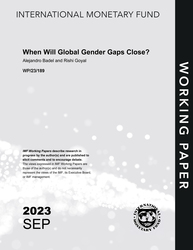
When Will Global Gender Gaps Close?
When Will Global Gender Gaps Close?
READ MORE...
Volume/Issue:
Volume 2023
Issue 189
Publication date: September 2023
ISBN: 9798400249044
$20.00
Add to Cart by clicking price of the language and format you'd like to purchase
Available Languages and Formats
| English |
Prices in red indicate formats that are not yet available but are forthcoming.
Topics covered in this book
This title contains information about the following subjects.
Click on a subject if you would like to see other titles with the same subjects.
Labor , Economics- Macroeconomics , Economics / General , Gender Studies , Gender Gap , Dynamics , Convergence , Cross-Country , Global , Labor Supply , Labor Force Participation , Female , Distribution , U-shaped transition , , IMF Gender Data Hub , IMF working paper 23/189 , UK's Foreign , Commonwealth and Development Office , long-run distribution of gender gaps , gender LFP gap , Gender inequality , Women , Income
Summary
On the current pace of reforms, global gender gaps are estimated to close, using deterministic (linear or log-linear) trends, over the next three centuries. This means that many women will likely not be able to fully use their abilities and talents, to the detriment of societies, for a long time. Yet this paper shows that, absent a significant step up in policy efforts, gender gaps may in fact never close. Using Markov chains, a common approach in macroeconomics, this paper analyzes the dynamics of the cross-country distribution of the gender gap in labor force participation. This methodology does not impose strong restrictions on the data, allowing for episodes of progress as well as regress by countries on gender inequality. Based on the experience of the past three decades, the analysis predicts a further narrowing of gender gaps over time. But the long-run distribution of gender gaps in labor force participation features a substantial share of countries with persistently large gaps, implying that—absent a strengthened and systematic policy effort—some of the current misallocation of women’s talents and abilities could persist perpetually.
Copyright © 2010 - 2025
Powered by:
AIDC



